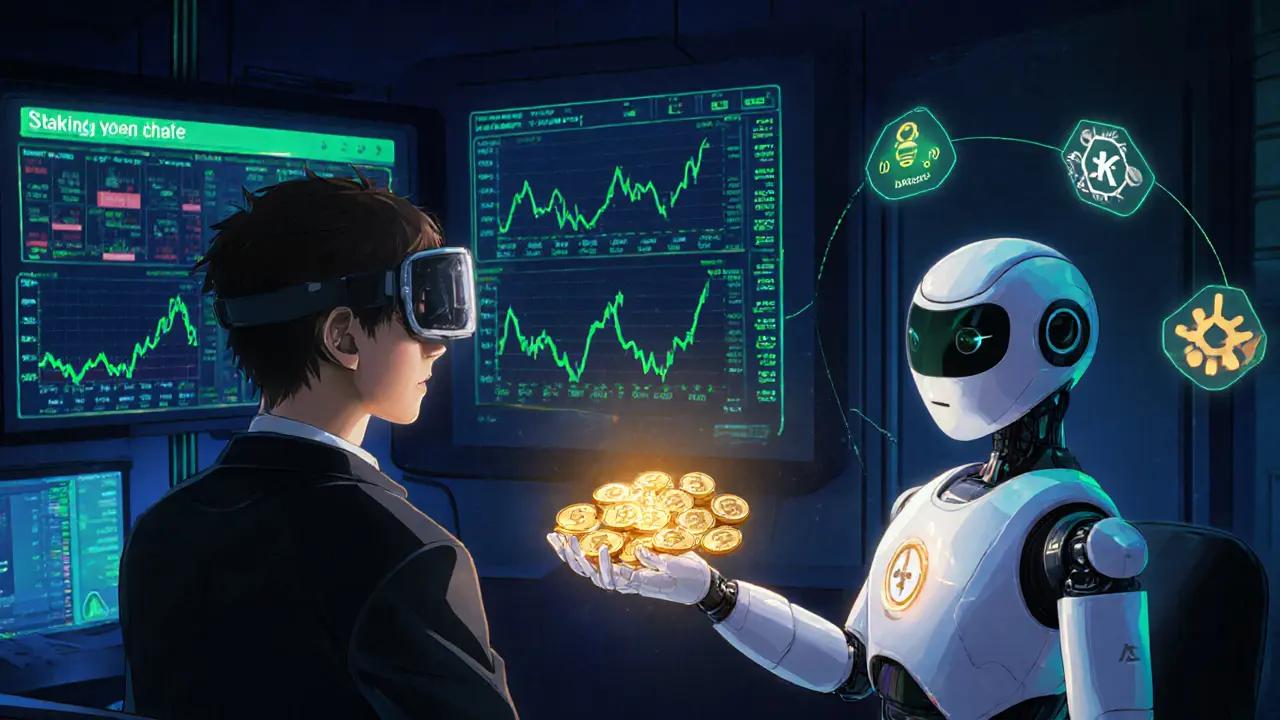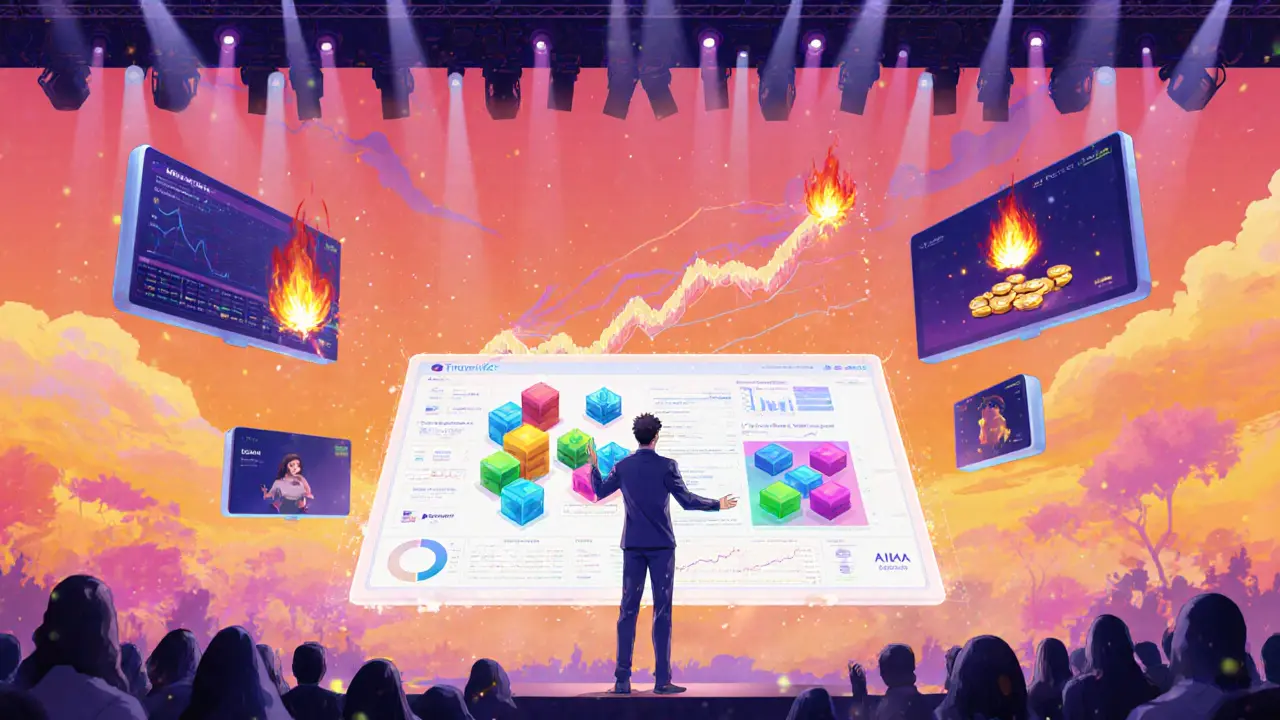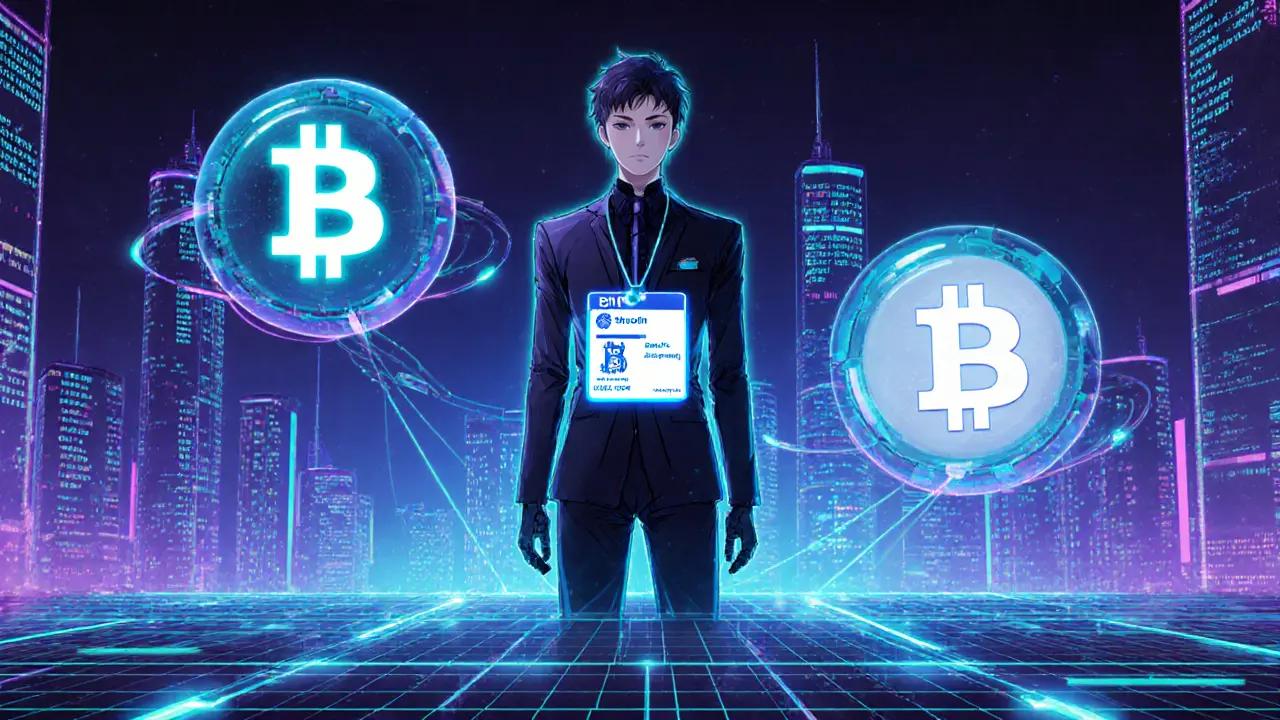DeAgentAI (AIA) Token Value Calculator
Current Token Metrics
Current Price:
$0.475
Market Cap:
$47.3M
Circulating Supply:
99.5M AIA
Fully-Diluted Valuation:
$475.6M
24h Change:
+3.58%
Investment Calculator
Investment Results
Market Performance Overview
When you hear the buzz around AI‑powered blockchains, you may wonder whether any project actually delivers usable tools or just hype. DeAgentAI is one of the few that has built a concrete stack for autonomous agents on Web3, backed by a native AIA token. This guide walks you through the token’s purpose, its core products, market behaviour, and where the road ahead leads.
Quick Takeaways
- DeAgentAI provides an AI agent infrastructure that runs on Sui, BNB Smart Chain and Bitcoin.
- The AIA token fuels services, staking, governance and buy‑back‑burn mechanics.
- AlphaX, the live prediction engine, already serves over 400k daily users with >70% accuracy.
- Two more products-CorrAI (no‑code strategy builder) and Truesights (InfoFi platform)-are slated for 2026.
- Token price hovers around $0.48, with a circulating market cap of $47M and a fully‑diluted valuation near $475M.
What is DeAgentAI?
At its core, DeAgentAI is an AI agent infrastructure project that lets developers create, deploy and coordinate autonomous software agents on public blockchains. The platform tackles three technical pain points that have long plagued on‑chain AI:
- Identity - each agent gets a unique, verifiable on‑chain ID.
- Continuity - state and memory persist across transactions.
- Consensus - agents reach agreement on shared data without central control.
These capabilities are delivered via modular components: an identity system, a memory manager, a lifecycle coordinator, and a consensus layer that can hook into any smart‑contract platform. Today the stack is live on three networks:
- Sui - a high‑throughput layer‑1 focused on data‑parallel execution.
- BNB Smart Chain (BSC) - Ethereum‑compatible, low‑fee environment.
- Bitcoin - through a side‑chain integration that brings agent logic to the world’s most secure ledger.
By being multi‑chain, DeAgentAI lets a single agent’s identity travel across ecosystems while preserving its state, a feature rarely seen outside enterprise solutions.
AIA Token Mechanics and Tokenomics
The AIA token is the economic spine of the ecosystem. Here are its main utility hooks:
- Service Fees - Users pay AIA to run predictions on AlphaX or to call AI‑enhanced smart contracts.
- Staking Rewards - Token holders can lock AIA to earn a share of platform revenue, which is partially earmarked for buy‑back‑burn.
- Governance - Each token represents one vote in protocol upgrades and product roadmap decisions.
- Incentive Distribution - Contributors to CorrAI, Truesights or community content earn AIA as performance bonuses.
The token follows a deflationary model: 5% of all fees collected are automatically used to purchase AIA on the open market, then permanently burn them. This creates a modest upward pressure on price, counterbalancing the relatively large circulating supply of 99.5million (about 10% of the 1billion max).
Key supply figures (as of October2025):
| Metric | Value |
|---|---|
| Total Supply | 1,000,000,000 AIA |
| Circulating Supply | 99,500,000 AIA (9.95%) |
| Market Cap (circulating) | $47.3M |
| Fully‑Diluted Valuation | $475.6M |
| Current Price | $0.475USD |

Core Products: AlphaX, CorrAI, and Truesights
AlphaX is the flagship offering-a real‑time crypto price‑prediction engine that analyzes on‑chain data, news sentiment and AI‑driven market models. Since launch, AlphaX has logged more than 192million on‑chain transactions and boasts a documented >70% hit‑rate for short‑term Bitcoin and Ethereum trends. Its user base exceeds 401,000 daily active participants, many of whom pay AIA for premium signal packages.
Two products are slated for early‑2026:
- CorrAI - a no‑code quantitative strategy builder that lets traders drag‑and‑drop AI modules to create custom bots without writing code.
- Truesights - an InfoFi platform that rewards accurate market insights and governance forecasts with AIA, aiming to crowdsource high‑quality research.
All three products share a common back‑end: the DeAgentAI identity and consensus layers, which guarantee that agents act transparently and that results are tamper‑proof.
Market Performance and Trading Landscape
When AIA hit Binance Alpha and Binance Futures on 18September2025, it vaulted to a fully‑diluted valuation of $457M within 24hours. Since then, price swings have been wide but decidedly upward in the medium term:
- +2.01% in the last hour
- +3.58% over 24hours
- +81.98% in the past 7days
- Steady 11.03% gain across 30‑, 60‑ and 90‑day windows
Daily trading volume sits near $26.5M, despite a recent 8.35% dip, reflecting strong liquidity across more than ten exchanges-including Binance, OKX and smaller DEX aggregators. The token currently ranks around #607‑#671 on major market trackers, a position that should improve as AlphaX and the upcoming tools attract institutional curiosity.
Backers, Partnerships, and Ecosystem Support
DeAgentAI’s capital raise totals $6M, sourced from a mix of venture firms that specialize in Web3 and AI:
- Web3.com Ventures
- SNZ Capital
- KuCoin Ventures
- Vertex Capital
- Valkyrie Fund
- Momentum, Waterdrip Capital, PANONY, Kernel Ventures, CatcherVC
Strategic integrations amplify reach:
- Binance Wallet - one‑click token deposits for futures trading.
- OKX Wallet - cross‑chain bridging to Sui.
- Native support in the Sui Network node software.
These partnerships reduce friction for developers who want to spin up agents, while also exposing AIA to a broader retail audience.
Use Cases, Risks, and Future Outlook
Real‑world use cases are already emerging:
- Automated Market‑Making - Agents execute arbitrage across DEXes, paying fees in AIA.
- Fraud Detection - AI models monitor transaction streams for abnormal patterns, rewarding alerts with token incentives.
- Decentralized Governance - Community proposals are evaluated by AI agents that simulate economic impact before voting.
Risks remain. Regulatory uncertainty around AI‑driven financial advice could affect AlphaX’s expansion in the EU. Security of multi‑chain agents also demands ongoing audits; a single compromised identity could propagate false signals across all supported networks.
Looking ahead, the biggest catalyst will be the launch of CorrAI and Truesights. If both deliver on their no‑code promises, DeAgentAI could become the default toolbox for anyone wanting AI‑enhanced crypto strategies, pushing AIA demand beyond pure transaction fees.

Frequently Asked Questions
What problem does DeAgentAI solve?
It gives developers a ready‑made stack to create autonomous agents that can identify themselves, keep memory, and reach consensus on any supported blockchain, removing the need to build these components from scratch.
How is the AIA token used within the platform?
AIA pays for prediction signals, funds staking rewards, grants voting power in governance, and fuels buy‑back‑burn operations that aim to increase token scarcity over time.
Is AlphaX profitable for a regular user?
AlphaX’s >70% short‑term accuracy can boost trading returns, but users still face market risk. The service is best used as a supplemental signal rather than a guaranteed profit tool.
Where can I buy AIA?
AIA is listed on Binance (spot and futures), as well as on several smaller exchanges and DEX aggregators that support BNB Smart Chain and Sui.
What are the upcoming products and when will they launch?
CorrAI (no‑code strategy builder) and Truesights (InfoFi platform) are slated for Q1‑Q22026. Both will integrate directly with the DeAgentAI infrastructure and the AIA token economy.


Post Comments (23)
DeAgentAI’s tokenomics are fairly straightforward: the AIA token is used to pay for prediction services, staking rewards, and governance voting. The current circulating supply is about 99.5 million, which is roughly 10 % of the max supply, keeping the inflation rate modest. A 5 % fee on all platform transactions is automatically used for a buy‑back‑burn mechanism, adding a deflationary pressure over time. Stakers earn a share of the platform revenue, which further incentivises holding. Overall, the token serves both utility and a modest store‑of‑value function within the ecosystem.
DeAgentAI is shaping the next wave of on‑chain AI agents.
From a technical standpoint, DeAgentAI introduces a multi‑chain identity schema that resolves the longstanding challenge of agent provenance on heterogeneous ledgers. By leveraging cryptographic attestations, each AI agent acquires a verifiable on‑chain UUID, which can be referenced across Sui, BSC, and Bitcoin sidechains, thereby facilitating cross‑network interoperability. The memory manager component persists stateful data within a Merkle‑based storage layer, allowing agents to retain contextual information between discrete transaction executions-a capability that is essential for advanced predictive modeling. Consensus is achieved via a lightweight Byzantine Fault Tolerant protocol that aggregates votes from a quorum of validator nodes, ensuring that global state transitions are both deterministic and tamper‑resistant. The tokenomics reinforce this architecture: a 5 % transaction fee is earmarked for an algorithmic buy‑back‑burn cycle, effectively creating a negative pressure on supply while aligning incentives for token holders. Staking contracts distribute platform revenue proportionally, providing a passive yield that can be reinvested into further agent development. Governance is executed on‑chain, with each AIA token representing a single vote, enabling a token‑weighted decision framework for protocol upgrades and product roadmaps. The ecosystem’s strategic partnerships with Binance and OKX wallets lower onboarding friction, granting users one‑click deposit capabilities that accelerate adoption. Moreover, the upcoming CorrAI no‑code builder is poised to democratize AI strategy formulation, reducing the barrier to entry for non‑technical traders. Truesights, the InfoFi platform, will further enrich the data ecosystem by rewarding high‑quality market insights with token incentives, thereby fostering a virtuous cycle of information and liquidity. Regulatory considerations remain a variable; the EU’s forthcoming AI Act could impose compliance obligations on on‑chain predictive services, potentially affecting AlphaX’s market reach. Security audits are imperative, as a compromised agent identity could propagate malicious logic across all supported chains, undermining trust. Nevertheless, the modularity of the DeAgentAI stack permits independent audits of each component, mitigating systemic risk. In sum, the project’s technical foundation, combined with a balanced token utility model and a clear product pipeline, positions it as a notable contender in the burgeoning on‑chain AI domain.
What really excites me about DeAgentAI is the philosophical shift it represents-moving from static smart contracts to living, learning agents that can adapt to market dynamics. AlphaX’s reported 70 % short‑term accuracy isn’t just a number; it hints at the potential for AI‑augmented trading to become mainstream. If CorrAI lives up to its promise of drag‑and‑drop AI strategies, we could see a wave of retail users deploying sophisticated bots without ever touching code. The synergy between the identity layer and cross‑chain execution means these agents could arbitrage opportunities across disparate ecosystems in real time. It’s a compelling vision that bridges AI research and decentralized finance.
I think the community can really benefit from keeping an eye on the staking reward rates-those can fluctuate as platform revenue changes. Also, the buy‑back‑burn mechanism adds a nice deflationary angle, but it’s good to remember that price will still be driven by actual usage of the services. If AlphaX continues to deliver solid signals, more traders will pay fees in AIA, which could create a positive feedback loop. It’s worth watching the volume metrics on the exchanges, too; higher liquidity generally supports healthier price action.
Token utility covers fees staking governance rewards and buy back burn keep it simple
The whole project feels like a hype train built on shaky code and speculative buzz, with no real moat.
While it’s easy to dismiss the hype, the underlying tech actually offers a tangible upgrade to how agents can operate across chains. The cross‑chain identity is a solid differentiator, and if the upcoming tools deliver on usability, the token could see genuine demand beyond pure speculation.
From a national perspective, supporting home‑grown blockchain initiatives is crucial for economic sovereignty. Projects like DeAgentAI that push AI integration into decentralized finance can showcase our country’s tech capabilities on a global stage. It’s important that we back such innovators to stay competitive.
Interesting take – I see the cross‑cultural potential here. By enabling agents to work on different networks, the project bridges communities that usually operate in silos, fostering a more inclusive crypto ecosystem.
Imagine a future where AI agents not only trade but also help moderate community discussions, flagging misinformation in real time. That could be a game‑changer for governance and trust within decentralized platforms.
DeAgentAI’s roadmap reads like a manifesto for the next generation of decentralized AI services. The multi‑chain vision is ambitious, and if executed well, it could set a precedent for interoperability standards. However, the sheer breadth of the product suite risks spreading resources thin; focusing on delivering a polished AlphaX experience should remain top priority before rolling out CorrAI and Truesights. Balancing speed to market with rigorous security audits will be essential, as any breach could undermine confidence across all supported chains. The token’s deflationary mechanics are clever, yet they alone won’t sustain price without sustained demand for the platform’s services. Community engagement, transparent governance, and clear metrics on agent performance will be the true drivers of long‑term value. In short, the concept is compelling, but execution will determine whether it becomes a cornerstone of on‑chain AI or just another speculative venture.
While many hail DeAgentAI as a breakthrough, one must consider that the market is saturated with over‑promised AI projects that lack substantive differentiation. The purported cross‑chain capabilities, though novel, risk being rendered moot should a major protocol fork or regulatory clampdown occur. Moreover, the reliance on token‑based incentives could foster speculative behavior rather than genuine utility, ultimately destabilizing the ecosystem.
Hey folks, absolutely love the inclusive vibe of the community here-let’s keep cheering each other on as these tools mature. The more we share insights, the faster the ecosystem grows, and that’s a win‑win for everyone.
Sounds like they’re overhyping a simple token with a few fancy charts.
It’s encouraging to see projects that aim to bridge cultural divides via technology. DeAgentAI’s multi‑chain approach could foster collaboration between developers from different regions, enriching the global blockchain tapestry.
👍 The token’s utility seems solid, especially with the staking rewards and governance voting. If the platform’s usage metrics keep climbing, we could see a healthy ecosystem develop. Keep an eye on the community updates for any new feature drops! 🚀
From a contrarian perspective, the heavy reliance on AI predictions could be a double‑edged sword-if market volatility spikes, those models might underperform, leading to token sell‑offs. Still, the modular design offers some resilience.
Honestly, the jargon around “buy‑back‑burn” feels like a band‑aid over nothing substantial. It’s a nice PR line, but without real adoption of the underlying services, the token’s value remains speculative.
The philosophical implications of autonomous on‑chain agents are fascinating-yet we must remain critical of the hype. If the platform can deliver measurable ROI for users, then the lofty ideals will find practical grounding.
Let’s stay respectful and focus on constructive feedback; the project has potential, and thoughtful discussion will help it improve.
meh, looks like another token trying to ride the AI wave… 🙄
From an ethical standpoint, it is imperative that any platform integrating AI within financial services adheres to rigorous standards of transparency, accountability, and user consent. The token economics should not be leveraged to obscure the true risk exposure of participants. Stakeholders must demand independent audits and clear disclosure of algorithmic decision‑making processes to safeguard against systemic manipulation.